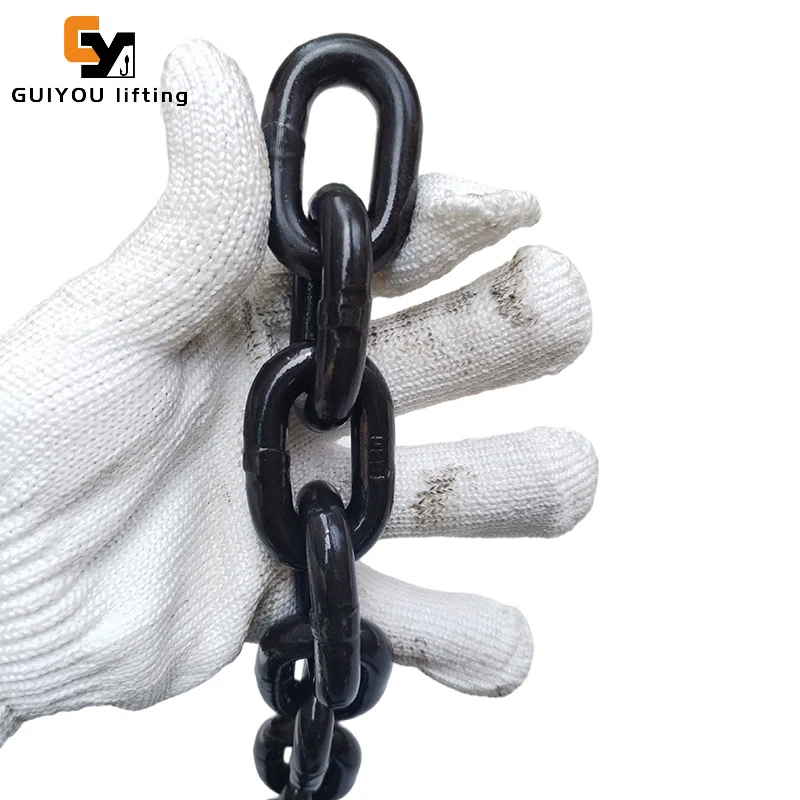lifting chain size
| size | inside max.s | outside max.s | weight kg/m | W.L.L.T | test load kn | min breaking load kn |
| 6×18 | 7.5 | 21 | 0.79 | 1.1 | 27 | 45.2 |
| 7×21 | 9 | 24.5 | 1.07 | 1.5 | 37 | 61.6 |
| 8×24 | 10 | 28 | 1.38 | 2 | 48 | 80.4 |
| 10×30 | 12.5 | 35 | 2.2 | 3.2 | 76 | 125 |
| 12×36 | 15 | 42 | 3.1 | 4.6 | 109 | 181 |
| 13×39 | 16.3 | 46 | 3.8 | 5 | 128 | 214 |
| 14×42 | 18 | 49 | 4.13 | 6.3 | 150 | 250 |
| 16×48 | 20 | 56 | 5.63 | 8 | 192 | 320 |
| 18×54 | 23 | 63 | 6.85 | 10 | 246 | 410 |
| 20×60 | 25 | 70 | 8.6 | 12.5 | 300 | 500 |
| 22×66 | 28 | 77 | 10.2 | 15.3 | 366 | 610 |
| 26×78 | 35 | 91 | 14.87 | 21.3 | 510 | 850 |
| 30×90 | 38 | 105 | 19.6 | 28.3 | 678 | 1130 |
| 32×96 | 40 | 106 | 22.92 | 32.2 | 772 | 1286 |
Lifting Chains: The Powerful Backbone of the Industrial Sector
As core components of lifting machinery and hoisting equipment, lifting chains are widely used in construction, manufacturing, logistics, mining, and other fields to perform critical tasks such as hoisting, pulling, and securing heavy loads. Their high strength, durability, and reliability make them indispensable tools in industrial operations. Below is a detailed overview of lifting chains, covering their structure, materials, applications, selection, and maintenance.
1. Structure and Classification of Lifting Chains
Lifting chains consist of interlinked metal rings and are generally categorized into two types:
Welded Chains: Closed via welding, these chains have smooth surfaces and are suitable for standard load scenarios.
Drop-Forged Chains: Manufactured using high-temperature forging, these chains offer superior strength and fatigue resistance, making them ideal for heavy-duty, high-frequency operations.
Chains can also be classified by ring shape, such as standard round-link chains, oval-link chains, and long-link chains, each designed for specific operational needs.
2. Materials and Manufacturing Processes
Lifting chains are primarily made of high-strength alloy steel (e.g., 20Mn2, 25MnV). Key manufacturing processes include:
Heat Treatment: Quenching and tempering enhance hardness, tensile strength, and wear resistance.
Surface Treatment: Galvanizing, black oxide coating, or anti-corrosion layers improve rust resistance for outdoor use.
Rigorous Quality Control: Each chain undergoes load testing, flaw detection, and compliance checks with international standards (e.g., ISO, DIN, ASME).
3. Core Advantages and Features
High Load-Bearing Capacity: Breaking strength ranges from hundreds to thousands of tons, suitable for lifting large equipment, steel structures, and containers.
Durability and Safety: Advanced materials ensure stability in extreme temperatures, humidity, and high-impact environments.
Versatility: Compatible with hand chain hoists, electric hoists, and cranes for vertical lifting, horizontal pulling, and more.
Low Maintenance: Simple structure requiring only regular lubrication and inspections.
4. Key Application Areas
Construction: Hoisting steel beams, precast concrete components.
Manufacturing: Installing production line machinery, moving heavy equipment.
Port Logistics: Container handling, ship cargo securing.
Mining and Energy: Ore transport, underground equipment maintenance.
Emergency Response: Removing heavy debris at accident sites.
5. Selection and Usage Guidelines
Choose the Right Specifications: Match chain diameter, length, and grade (e.g., G80, G100) to working load, frequency, and environment.
Regular Inspection and Maintenance: Check for deformation, wear, or cracks. Clean and lubricate chains regularly. Avoid overloading or sudden shocks.
Retirement Criteria: Replace chains if elongation exceeds 3%, wear exceeds 10%, or severe corrosion is present.









Contact us for more product information

Company vision
Through continuous improvement and
technologica innovation, we collaborate withcustomers and employees to forge a new chapterinn manufacturing.
Contact Information
- Phone: +86 15803123771
- WhatsApp:+86 15803123771
- Address:Donglv Development Zone,Qingyuan County,Baoding, Hebei,China.









